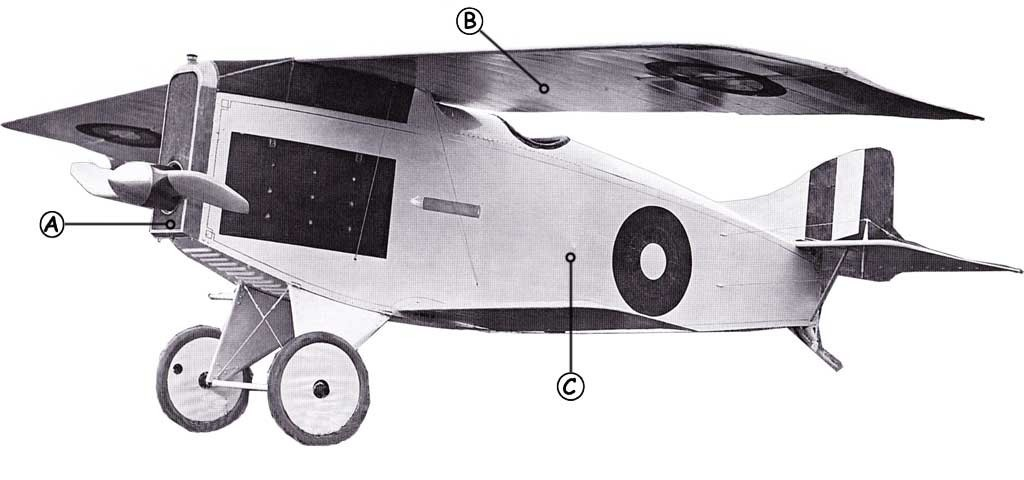
Military aviation has always been a proving ground for bizarre schemes and high-risk experimentation. When hostilities are at hand and pressure is on, air forces and patriotic engineers have been willing to roll the dice on designs that would seem more at home in a Saturday matinee science fiction serial. Some of these bizarre creations crashed and burned spectacularly, others muddled their way toward surprise successes, and a few pushed technology into directions no one would have anticipated. Here’s a countdown of ten of the strangest military aircraft ever to fly, ranging from “weird but functional” to “what were they thinking?”

10. The Christmas Bullet
If there were a prize for worst airplane ever constructed, the Christmas Bullet would win hands down. Conceived in 1918 by Dr. William Whitney Christmas, a physician with no formal engineering training, it arrived with the preposterous assertion that it could close out World War I by flying to Germany, abducting the Kaiser, and flying back home. The design flew in the face of elementary aeronautics: Christmas insisted that the wings must flap as a bird’s and would not permit struts or braces. The consequence? Both prototypes disintegrated in mid-air during their short test flights, taking the test pilots with them. Its sole actual contribution was to secure a permanent place in the hall of shame of aviation.

9. Curtiss-Wright XP-55 Ascender
Codename the “Ass-Ender,” this 1940s American prototype turned the fighter equation on its head with a pusher prop at the rear, canard foreplanes at the front, and twin vertical tails. The theory was improved pilot view and a free nose for weapons. In practice, the XP-55 had terrible stall behavior and was slower than other fighters. Only three were constructed, and two were destroyed in crashes, so the Ass-Ender is most remembered for its eccentricities rather than its flight characteristics.

8. Vought V-173 “Flying Pancake”
The V-173 resembled a giant disk and, more than any other airplane, resembled a UFO rather than a fighter. Designed by World War II designer Charles Zimmerman, it utilized its entire body as a lifting surface and rotated two huge propellers to produce extremely short takeoff, perhaps even near-vertical lift. Test pilots discovered it could nearly hover and fly more like a helicopter than an aircraft.

But when the future turned to jet engines, the Navy stepped aside, leaving the Pancake one of the most fanciful “what-ifs” of the age.

7. Northrop XP-79 “Flying Ram”
The title is enough: this plane was designed to kill enemy bombers by ramming them. Constructed in WWII from a magnesium welding shell, the XP-79 was intended to be fast, agile, and resilient enough to take ramming strikes. Its flight career ended nearly before it started—on its maiden flight, it crashed, killing pilot Harry Crosby.

The program was ended at once, but it’s a stunning example of how far designers would take things in wartime.

6. Convair XFY Pogo
During the 1950s, the U.S. Navy considered a vertical takeoff fighter that could launch from small ships. The Pogo was the product—a “tailsitter” with contra-rotating propellers and immense power that could take off vertically and land on its tail. Brilliant on paper; hell in the cockpit. Pilots had a hard time hovering and found it nigh impossible to shift from vertical to horizontal flight.

The idea was shelved quietly, but Togo’s rocket-like posture is not soon forgotten.

5. Ryan X-13 Vertijet
If the Pogo was finicky, the X-13 was downright brutal. This jet-powered tailsitter could take off and land vertically, cruise horizontally, and return to land nose-up, suspended from a special recovery hook. It demonstrated that the concept could work, but landings were hair-raisingly tricky and needed an entire ballet of support gear. The idea was put on hold, but the Vertijet’s risky test flights drove VTOL research ahead.

4. Horten Ho 229
Half stealth test, half science fiction dream sequence, the Ho 229 was a jet-powered flying wing constructed by Germany during WWII. The Horten brothers got rid of the classic fuselage and tail, streamlining everything into a smooth, tailless wing. The result was clean, aerodynamic, and—accidentally—more difficult to spot on radar.

It achieved a few successful flights before Germany’s surrender, and although it never engaged in combat, its lineage can be seen in contemporary stealth planes such as the B-2 Spirit.

3. Convair F2Y Sea Dart
A supersonic fighter that could land on the water? That was the sell on the Sea Dart, which employed retractable hydro-skis to skim above waves when taking off and landing. It did fly at supersonic speeds in straight and level flight—a first for a seaplane—but poor handling on the water and one fatal accident made its chances vanish. The Sea Dart is still the sole supersonic seaplane fighter ever.

2. Rockwell HiMAT
The Highly Maneuverable Aircraft Technology program of the 1970s experimented with just how much agility a fighter could possess. The HiMAT was a thin, delta-wing, remote-controlled jet that could withstand extreme G-forces at high velocity. It was a group effort to fly it, too—five pilots operated it jointly to control each test flight remotely. It was never designed for combat, but what it yielded was data that shaped fighter designs for generations to come.

1. Nord 1500 Griffon
France’s Nord 1500 Griffon appeared as swift as it flew. First appearing in 1955, it had a canard configuration combined with forward-swept wings and a hybrid powerplant—turbojet to lift off, ramjet for scorching speed. In 1959, Griffon II reached 2,320 km/h, a record. But the ramjet’s complexity and residual technical issues consigned it to the prototype level.

Nevertheless, it is one of the most striking experimental jets ever constructed. From flapping-wing fantasies to flying saucers, these eccentric contraptions demonstrate that military ingenuity isn’t always about being conventional. For every sleek, battle-worthy fighter in the annals of history, there’s a weird, obscure prototype in a museum—quiet testimony that sometimes you must attempt the bizarre to discover the brilliant.
